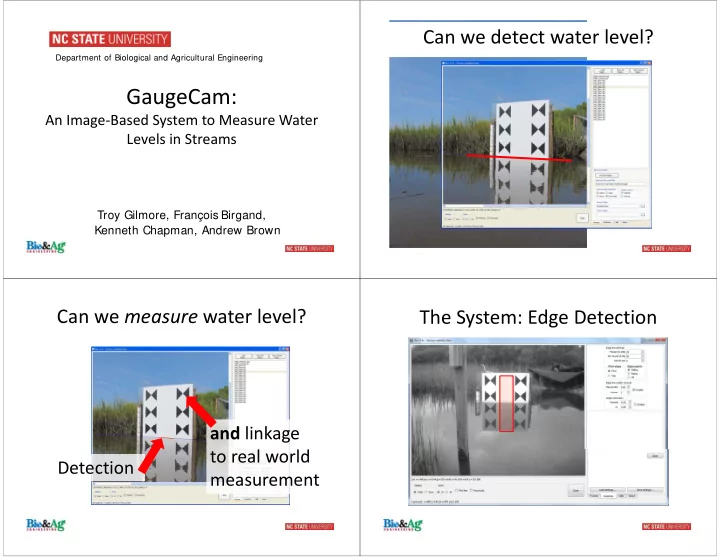

Can we detect water level? Department of Biological and Agricultural Engineering GaugeCam: An Image ‐ Based System to Measure Water Levels in Streams Troy Gilmore, François Birgand, Kenneth Chapman, Andrew Brown Can we measure water level? The System: Edge Detection and linkage to real world Detection measurement
The System: Edge Detection The System: Edge Detection The System: Calibration The System: Edge Detection
The System: Calibration Lab Research Objective: x = 0 cm, y = 75 cm Quantify source and magnitude of uncertainty when measuring water level with images Uncertainty: Sources Uncertainty: Three Experiments 1. Image Resolution Benchmark I 1. Image Resolution 2. Lighting effects 2. Lighting effects Benchmark II 3. Perspective 3. Perspective Water Level 4. Lens distortion 4. Lens distortion 5. Water meniscus 5. Water meniscus
Uncertainty: Three Experiments Uncertainty: Benchmark I Benchmark I 1. Image Resolution 2. Lighting effects 3. Perspective v v v v 4. Lens distortion 5. Water meniscus Uncertainty: Benchmark I Uncertainty: Benchmark I v v v v 0.5 cm/pixel 0.25 cm/pixel
Benchmark I: RESULTS Uncertainty Calculation • Many images per resolution Mean Bias, SD, RMSE (cm) • Error = measured – known value • Calculated distribution of errors for each resolution • Calculated bias, SD and RMSE of each distribution High res cm per pixel Lo res Uncertainty: Three Experiments Benchmark I: RESULTS ~ 5 m ~ 7 m Benchmark I 1. Image Resolution 16 mm lens 16 mm lens Mean Bias, SD, RMSE (cm) 2. Lighting effects Benchmark II 3. Perspective 4. Lens distortion 5. Water meniscus cm per pixel
Uncertainty: Sources Benchmark II Perspective Lighting (Bloom) Lens Distortion Benchmark II: RESULTS Benchmark II: RESULTS Night Mean Bias, SD, RMSE (cm) Mean Bias, SD, RMSE (cm) 4 m RMSE Day 12 mm lens RMSE Std Dev Mean Bias 5 m 6 m 7 m cm per pixel cm per pixel
Uncertainty: Camera effects Uncertainty: Three Experiments Benchmark I 1. Image Resolution Lighting* 2. Lighting effects* Benchmark II 3. Perspective Water Level 4. Lens distortion Meniscus Effects 5. Water meniscus Water Level: RESULTS Water Level: Posture Angle Mean Bias, SD, RMSE (cm) 10 deg 19 deg 5 m 4m, 12 mm 6 m 7 m For camera at 6 meters cm per pixel
Water Level: 6m, 16mm lens Conclusions Bias (cm) 1. Lens distortion must be minimized 2. Posture angle may interact with meniscus 3. With reasonable precautions, accuracy of +/ ‐ 3 mm (0.01 ft) is achievable in the lab 19 10 posture angle from horizontal (degrees) Acknowledgements Salt Marsh Images: Randall Etheridge, Brad Smith Lab Analysis Assistance: Kelly Chapman Camera Equipment: www.Microseven.com www.Colorado ‐ Video.com Software: www.GaugeCam.com Check out our ASABE 2011 booth! Louisville Belle waterline
Recommend
More recommend